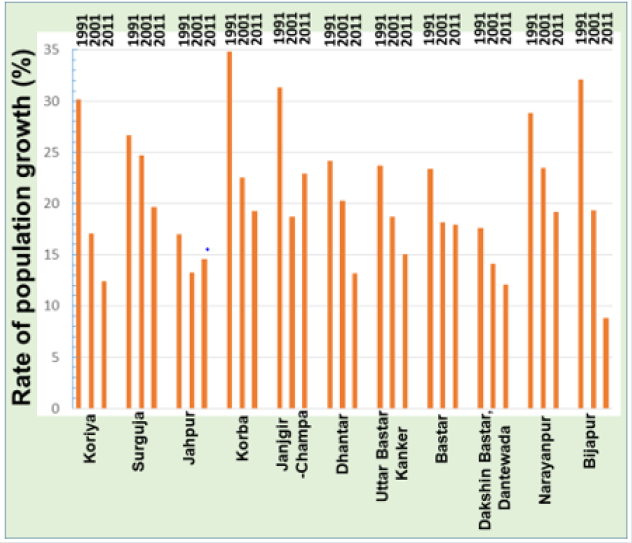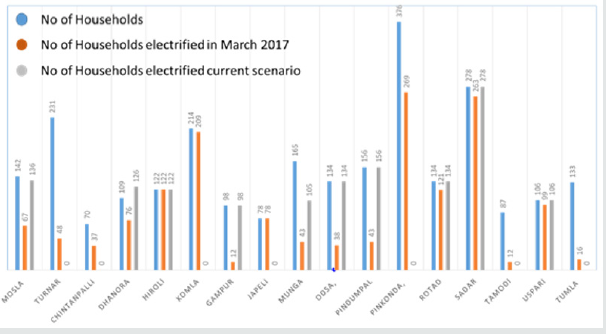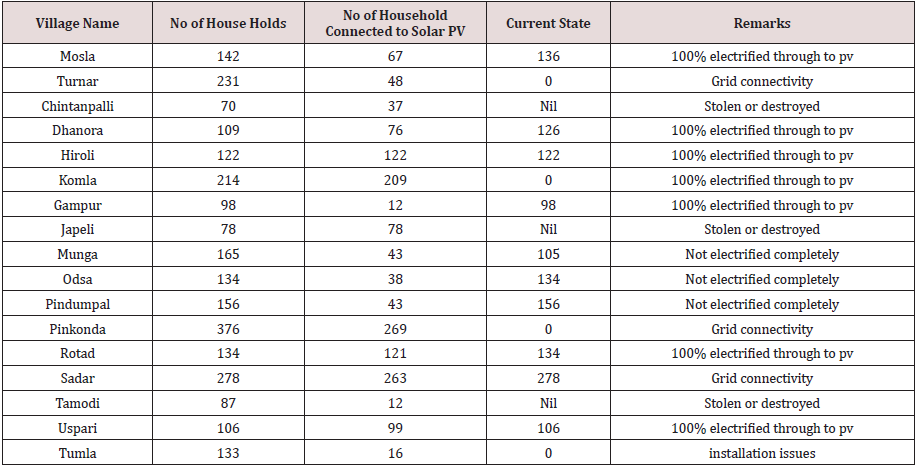
Lupine Publishers Group
Lupine Publishers
Menu
ISSN: 2643-6736
Mini Review(ISSN: 2643-6736) 
Assessment of On-Grid and Off-Grid Electrification in Remote Villages of Chhattisgarh Volume 2 - Issue 4
Saurabh Pathak1,2* and Rajni Verma1,3
- 1School of Engineering, RMIT University, Australia
- 2Department of Mechanical Engineering, University of Melbourne, Parkville, Australia
- 3School of Physics, The University of Melbourne, Australia
Received: March 17, 2020; Published: June 09, 2020
Corresponding author: School of Engineering, RMIT University, Department of Mechanical Engineering, University of Melbourne, Parkville, VIC, 3010 Australia
DOI: 10.32474/ARME.2020.02.000142
Abstract
In this work, electrification scenario of the state of Chhattisgarh has been presented, which is the 10th largest state of India with a total population 25 million has total 19567 villages and 80% of the population lives in rural areas. Herein, we have bestowing 17 out of 133 villages in which electrification has been done in 2017 and 2018. All these villages are in the region Dantewada and Bijapur. These two regions consist most remote villages of the state and the awareness about, how electricity will help them in improving their lifestyle is quite less. The focus of the present work is aligned to investigate the electricity connectivity scenario of these remote villages. Further, alternative novel mechanism of the remote village electrification using magnetic fluid-based energy harvesting has been proposed which can eventually solves the major issues in remote village electrification.
Introduction
Electricity is one of the most basic need of the population
in recent times and it significantly affects the quality of life.
Electricity can transform the rural areas in many ways. Availability
of electricity in rural areas will reduce the manual workload for
food processing and longer working hours in the households, end
of smoky households etc. It will yield direct positive impact at
household, individual and community level. Electrifying a remote
village household can significantly lower the energy expenditures
made on kerosene and fuels which can be substituted by straight
electricity admittance. Further, it provides the family living in
the household with more working time that eventually fallouts
in improving the overall quality of life and productivity of each
household [1]. Although, the casual relationship between the
electricity and quality of life has not been laid down, but it has been
long argued based on the available literature that it significantly
affects the quality of life both economically and productivity wise.
So, the focused my present work is to understand the effect of
electrification on the ruler masses of the Chhattisgarh. We have
surveyed 17 villages in remote areas of Chhattisgarh by visiting 3
villages Dhanora, Gampur and Pinkonda in person and in rest of
the 14 villages by contacting the school teachers and local peoples
through telephonic conversation. So, this work explains in detail the
current situation of these villages how solar power in the villages
is improved and further discuss the possibility of low maintenance
wind energy to meet the off-grid requirement for these village [2,
3].
Alternatively, another possible solution to meet the need of the
country is through wind energy. We have developed a magnetic
fluid-based power generator which is capable of working at low
wind speed and has the potential for meeting the need of the
small electricity loads in the villages. This device can generate
enough electricity for a small household needs. In all, the overall
aim to analyze the importance of electricity and its impact on the
livelihood of the households has been done satisfactory in these
villages. Magnetic fluid-based energy generator has the potential
to provide the solution to the current electrification needs of the
remote villages in India [4-9].
Consequences of Lower Livelihood Opportunities in Rural Areas
The growth of the population in Chhattisgarh’s rural areas has declined drastically in the last two decades. Bijapur and Dantewada are the two major regions of Chhattisgarh which has evident the most seaver effects of these problems. The major reason contributing to this decrease is attributed by the expert is, decrease in livelihood opportunities of the tribes due to deforestation. In Chhattisgarh, eleven regions of the state are fully or partially affected by decrease in population. The population growth rate of these eleven districts from 1991 to 2011 have been shown in Figure 1. We can clearly see from the Figure 1 that population growth in these regions has decreased very sharply. The maximum fall in the population growth rate has been observed by the regions Bijapur, and Korea. To rehabilitate tribal population back to their home, more and more livelihood opportunities such as employment, water, connectivity, electricity, better homes and basics amenities, needs to be created in these regions. Electrification is one of the major areas in these regions to boost the livelihood opportunities and uplift the living standards of the tribes [10, 11].
Renewable Energy in Chhattisgarh
Chhattisgarh is tried, tested and proved solar microgrids to
be the most successful means of remote area electrification. The
small state of Chhattisgarh which is very rich in minerals is covered
in almost 43% by the forest and safety apprehensions avert grid
electrification. This made it ideal for the authorities to explore solar
photo voltaic (PV) technology since the Electricity Act 2003 allows
distribution of electricity in villages without formal permission of
State Electricity Boards. The state agency, CREDA obtained the list
of un-electrified villages from Chhattisgarh State Electricity Board
and installed standalone solar home lighting systems in 500 villages
through 100 per cent subsidy program. The system comprised of
PV modules, cables, an inverter, a battery and two 11 Watt CFLs.
CREDA has also explored alternative methods and finally opted for
solar PV microgrids. The cost of setting up a microgrid (PV power
system and transmission cables) per household is Rs 25,000/- as
against a home-lighting system that costs Rs 14,000/-. Although
a microgrid is costlier compared to a home lighting system they
prevent theft and require minimal maintenance, hence the capital
funds invested is protected. Secondly, they increased the size of
a single module from 50 Wp to 75 Wp. Due to increased size and
heavy it was virtually difficult to steal this size of module [11].
A village Ravana about 100 km from the capital city of state
Raipur revealed immense satisfaction of the villagers. The positive
outcomes of the electrification in the village is: increase in literacy
and safety from wild animals. Prior to commissioning of solar PV
lights wild animals like leopards would haunt this village and take
away children but the illumination from solar power has scared wild animals. CREDA officials approached NMDC officials for their
support to solar PV projects to provide basic power to villages,
who readily agreed to share their CRS funds for electrification as it
meets their social goals. The village is 100% household electricity
connectivity and its improvement in the lives of the people is
evident of the importance of electricity [3].
Evaluation of Solar Photovoltaic In 17 Villages of Bijapur And Dantewada
In this work, we have focused our studies only to the 17 villages of Bijapur (Mosla, Turnar, Chintanpalli, Dhanora, Gampur, Hiroli, Komla) and Dantewada (Japeli, Munga, Odsa, Pindumpal, Pinkonda, Rotad, Sadar, Tamodi, Tumla, Uspari). The reason behind choosing this villages is due to the fact that, these villages were electrified by solar Photovoltaic in the year of March 2017 by CREDA. Thus, analyzing the performance of these village will surely let us know the actual state of sustainable electricity state in the villages [3]. During the visit to the village, we asked set of questions to the villagers regarding the electrification. Figure 2 and Table 1 shows the list of villages surveyed for the study. In this study, we have contacted the local peoples of the villages to know the actual status and also collected data from the tehsil offices. Further in the villages Turnar, Komla, Sadar and Pinkonda are now connected to the grids. These villages have been connected to the grid and now 50% of the households are connected to the grid in merely 6-month time. From this field survey, we have found that the village electrification is someway hampered due to rural population not being aware about the opportunities near to them. In many places in the villages we have visited, we found that the electricity has not been connected to the households due to unawareness about the government subsidies. The interation with the villagers was very fruitfull and students were very encouraged by knowing about the potential of electricity to their lives. Thus, in these villages remote village electrification is very advantageous over the grid connectivity.
Nanomagnetic Fluid-Based Wind Energy Harvester
Nanomagnetic fluid or Magnetic fluid (MF) -based wind energy power generation is novel invention which can efficiently converts input wind energy to electricity. This can be effectively used for the rural village electrification. Magnetic fluids are smart materials with unique properties which makes it very useful for many novel inventions such as sensing, thermal energy storage, EMI shielding, magnetic filters and dampers [8, 12]. MFs are fascinating material and provides unique features which are utilized for the energy conversion device. MF based power generator is an energy conversion device which converts air thrust into an electrical energy. We have developed a portable electric power generator, consisting of a combination of permanent magnets, ferrofluid bearings and solenoid coils, which is capable of converting wind or mechanical energy into electrical energy in an efficient way [13, 14]. The concept of generation of electricity is based on the same Faraday’s principle of electromagnetic induction. The incoming air rotates the fan blade, which further rotates the magnets which are connected via shaft. The design is made in such a way it is ergonomically compatible. Beneath the magnets, coils are placed. Magnets are dipped in MF thereby forming bearing which assists the relative motion between magnets and coil. Coils and ferrofluid bearing are separated by a thin non-porous sheet. The small portable setup on the rooftop can generate more than 100 watt of power which at low wind speed of 4 m/s due to low frictional properties of the MF which is the major advantage of the present system.
Conclusion
In this work, we have surveyed the rural electrification scenario of the state Chhattisgarh remote villages. We have focused my study limited to the 17 villages in the area Bijapur and Dantewada which are connected to the electricity through off grid systems. The efficient use to SHS and microgrids in the remote villages of Chhattisgarh has shown excellent potential and proving to be a reliable power supply option. The most prominent way to achieve 100% electrification is through off grid power supply. Alternatively, wind energy can be an efficient solution in these areas. Wind energy is much cheaper than but the only drawback with wind turbines is that they require high average wind speeds, we have proposed the novel system to deal with this problem. Magnetic fluid-based power generators have the ability to work with low wind speed also which makes it an efficient solution for the current needs.
References
- Zahnd A, Kimber HM (2009) Benefits from a renewable energy village electrification system. Renewable Energy34(2):362-368.
- Gmünder SM (2010) Life cycle assessment of village electrification based on straight jatropha oil in Chhattisgarh, India. Biomass and Bioenergy34(3):347-355.
- Millinger M, Mårlind T, Ahlgren EO (2012) Evaluation of Indian rural solar electrification: A case study in Chhattisgarh. Energy for Sustainable Development16(4): 486-492.
- Noorjahan (2018) Dipolar Interaction and Magneto-Viscoelasticity in Nanomagnetic Fluid. Journal of Nanoscience and Nanotechnology18(4):2746-2751.
- Mishra A (2019) Measurement of Static and Dynamic Magneto-Viscoelasticity in Facile Varying pH Synthesized CoFe2O4-Based Magnetic Fluid. IEEE Transactions on Magnetics 55(12):1-7.
- JahanN (2017) Enchancmentinviscoelasticpropertiesofflake-shapedironbasedmagnetorheologicalfluid using ferrofluid. Colloids and Surfaces A: Physicochemical and Engineering Aspects529:88-94.
- PathakS (2017) MagneticFluidBasedHighPrecisionTemperatureSensor.IEEESensorsJournalm 17(9):2670-2675.
- Pathak S (2019) Improved thermal performance of annular fin-shell tube storage system using magnetic fluid. Applied Energy239:1524-1535.
- Jain K (2019) Dynamic magneto-optical inversion in magnetic fluid using NanoMOKE. Journal of Magnetism and Magnetic Materials475:782-786.
- Palit D, Sarangi GK, Krithika PR (2014)Energising Rural India Using Distributed Generation: The Case of Solar Mini-Grids in Chhattisgarh State Indiain Mini-Grids for Rural Electrification of Developing Countries: Analysis and Case Studies from South Asia. In: Bhattacharyya SC(Eds.) and Palit D(Eds.) Springer International Publishing: Cham pp.313-342.
- JainM,Mital M,Syal M (2016) RuralElectrificationthroughSolarEnergy:InsightsfromChattisgarhState of India.International Journal of Environment and Sustainability [IJES] 5(2): 99-104.
- Noorjahan (2018) Improved magneto-viscoelasticity of cross-linked PVA hydrogels using magnetic nanoparticles. Colloids and Surfaces A: Physicochemical and Engineering Aspects539:273-279.
- Jain K, Pathak S, Pant RP (2016) Enhanced magnetic properties in ordered oriented ferrofibres. RSC Advances6(75):70943-70946.
- SinghA (2020) TuningthemagnetocrystallineanisotropyandspindynamicsinCoxZn1-xFe2O4(0 ≤ x ≤ 1) Journal of Magnetism and Magnetic Materials493:165737

Top Editors
-

Mark E Smith
Bio chemistry
University of Texas Medical Branch, USA -

Lawrence A Presley
Department of Criminal Justice
Liberty University, USA -

Thomas W Miller
Department of Psychiatry
University of Kentucky, USA -

Gjumrakch Aliev
Department of Medicine
Gally International Biomedical Research & Consulting LLC, USA -

Christopher Bryant
Department of Urbanisation and Agricultural
Montreal university, USA -

Robert William Frare
Oral & Maxillofacial Pathology
New York University, USA -

Rudolph Modesto Navari
Gastroenterology and Hepatology
University of Alabama, UK -

Andrew Hague
Department of Medicine
Universities of Bradford, UK -

George Gregory Buttigieg
Maltese College of Obstetrics and Gynaecology, Europe -

Chen-Hsiung Yeh
Oncology
Circulogene Theranostics, England -
.png)
Emilio Bucio-Carrillo
Radiation Chemistry
National University of Mexico, USA -
.jpg)
Casey J Grenier
Analytical Chemistry
Wentworth Institute of Technology, USA -
Hany Atalah
Minimally Invasive Surgery
Mercer University school of Medicine, USA -

Abu-Hussein Muhamad
Pediatric Dentistry
University of Athens , Greece

The annual scholar awards from Lupine Publishers honor a selected number Read More...








